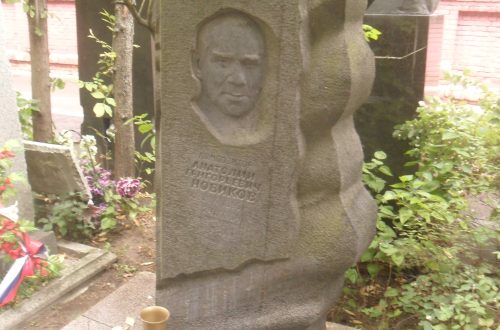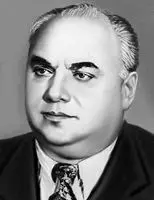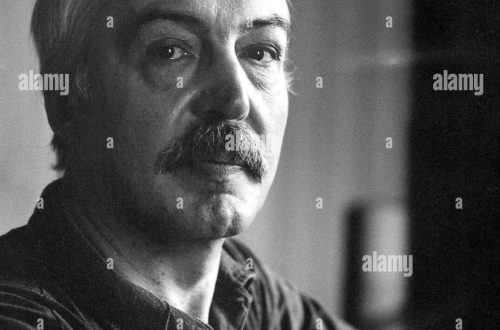
Moisey (Mechislav) Samuilovich Weinberg (Moisey Weinberg) |
Moisey Weinberg

The name of M. Weinberg is widely known in the music world. D. Shostakovich called him one of the outstanding composers of our time. An artist of great and original talent, deep intellect, Weinberg strikes with a variety of creative interests. Today, his legacy is 19 symphonies, 2 symphoniettes, 2 chamber symphonies, 7 operas, 4 operettas, 3 ballets, 17 string quartets, a quintet, 5 instrumental concertos and many sonatas, music for numerous films and cartoons, theatrical productions … Appeal to poetry Shakespeare and F. Schiller, M. Lermontov and F. Tyutchev, A. Fet and A. Blok gives an idea of the world of the composer’s chamber lyrics. Weinberg is attracted by the poems of Soviet poets – A. Tvardovsky, S. Galkin, L. Kvitko. The depth of comprehension of poetry was most fully reflected in the musical reading of the poems of the contemporary and compatriot composer Y. Tuwim, whose texts formed the basis of the Eighth (“Flowers of Poland”), Ninth (“Surviving lines”) symphonies, cantata Piotr Plaksin, vocal cycles. The composer’s talent is multifaceted – in his works he rises to the heights of tragedy and at the same time creates brilliant concert suites, full of humor and grace, the comic opera “Love d’Artagnan” and the ballet “The Golden Key”. The heroes of his symphonies are a philosopher, a subtle and gentle lyricist, an artist, reflecting on the fate and purpose of art, angrily protesting against the misanthropy and horrors of fascism of the tribunes.
In his art, Weinberg managed to find a special, inimitable style, while taking on the characteristic aspirations of modern music (turn towards chambernization, neoclassicism, searches in the field of genre synthesis). Each of his works is deep and serious, inspired by the most important events of the century, the thoughts of a great artist and citizen. Weinberg was born in Warsaw to a Jewish theater composer and violinist. The boy began to study music at the age of 10, and a few months later he made his debut as a pianist-accompanist in his father’s theater. At the age of 12 Mieczysław is a student at the Warsaw Conservatory. For eight years of study (Weinberg graduated from the conservatory in 1939, shortly before the outbreak of war), he brilliantly mastered the specialty of a pianist (subsequently, the composer would perform many of his compositions in various genres himself for the first time). During this period, the artistic guidelines of the future composer begin to be determined. In many ways, this was facilitated by the cultural life of Warsaw, especially the activities of the Philharmonic Society, which actively promoted Western European classics. The most profound impressions were made by such outstanding musicians as A. Rubinstein, S. Rachmaninov, P. Casals, F. Kreisler, O. Klemperer, B. Walter.
The war dramatically and tragically changed the life of the composer. The whole family dies, he himself, among the refugees, is forced to leave Poland. The Soviet Union becomes the second home of Weinberg. He settled in Minsk, entered the conservatory at the composition department in the class of V. Zolotarev, which he graduated in 1941. The creative results of these years are the Symphonic Poem, the Second Quartet, piano pieces. But formidable military events again break into the life of a musician – he becomes a witness to the terrible destruction of the Soviet land. Weinberg is evacuated to Tashkent, goes to work at the Opera and Ballet Theatre. Here he writes the First Symphony, which was destined to play a special role in the fate of the composer. In 1943, Weinberg sent the score to Shostakovich, hoping to get his opinion. The answer was a government call organized by Dmitry Dmitrievich to Moscow. Since then, Weinberg has been living and working in Moscow, since that year the two musicians have been linked by a strong, sincere friendship. Weinberg regularly showed Shostakovich all his compositions. The scale and depth of concepts, appeal to themes of wide public resonance, philosophical understanding of such eternal themes of art as life and death, beauty, love – these qualities of Shostakovich’s music turned out to be akin to Weinberg’s creative guidelines and found an original implementation in his works.
The main theme of Weinberg’s art is war, death and destruction as symbols of evil. Life itself, the tragic twists of fate forced the composer to write about the terrible events of the past war, to turn “to the memory, and therefore to the conscience of each of us.” Passed through the consciousness and soul of the lyrical hero (behind whom, undoubtedly, stands the author himself – a man of amazing spiritual generosity, gentleness, natural modesty), the tragic events acquired a special, lyric-philosophical connotation. And this is the individual uniqueness of all the composer’s music.
The theme of the war was most vividly embodied in the Third (1949), Sixth (1962), Eighth (1964), Ninth (1967) symphonies, in the symphonic trilogy Crossing the Threshold of War (Seventeenth – 1984, Eighteenth – 1984, Nineteenth – 1985); in the cantata “Diary of Love”, dedicated to the memory of the children who died in Auschwitz (1965); in Requiem (1965); in the operas The Passenger (1968), Madonna and the Soldier (1970), in a number of quartets. “Music is written with the blood of the heart. It is bright and figurative, there is not a single “empty”, indifferent note in it. Everything is experienced and comprehended by the composer, everything is expressed truthfully, passionately. I perceive it as a hymn to a person, a hymn of international solidarity of people against the most terrible evil in the world — fascism,” these words of Shostakovich, referring to the opera “Passenger”, can rightfully be attributed to Weinberg’s entire work, they accurately reveal the essence of many of his compositions. .
A special thread in Weinberg’s work is the theme of childhood. Embodied in a variety of genres, it has become a symbol of moral purity, truth and goodness, the personification of humanity, characteristic of all the composer’s music. The theme of art is connected with it as a carrier of the idea of the eternity of universal culture and moral values, important for the author. The figurative and emotional structure of Weinberg’s music was reflected in the specific features of melody, timbre dramaturgy, and orchestral writing. The melodic style grew up on the basis of songs associated with folklore. Interest in the intonational dictionary of Slavic and Jewish songs, which was most strongly manifested at the turn of the 40-50s. (At this time, Weinberg wrote symphonic suites: “Rhapsody on Moldavian Themes”, “Polish Melodies”, “Rhapsody on Slavic Themes”, “Moldavian Rhapsody for Violin and Orchestra”), affected the melodic originality of all subsequent compositions. The national origins of creativity, in particular Jewish and Polish, determined the timbre palette of the works. Dramaturgically, the most significant themes – carriers of the main idea of the work – are entrusted to favorite instruments – violins or flutes and clarinets. Weinberg’s orchestral writing is characterized by graphically clear linearity combined with intimacy. The Second (1945), the Seventh (1964), the Tenth (1968), symphonies, the Second Symphonietta (1960), two chamber symphonies (1986, 1987) were written for the chamber composition.
80s marked by the creation of a number of significant works, testifying to the full flowering of the composer’s powerful talent. It is symbolic that Weinberg’s last completed work, the opera The Idiot based on the novel by F. Dostoevsky, is an appeal to a composition whose super-task (“depicting a positively beautiful person, finding an ideal”) is completely in tune with the idea of the composer’s entire work. Each of his new works is another passionate appeal to people, behind each musical concept there is always a person “feeling, thinking, breathing, suffering”.
O. Dashevskaya





